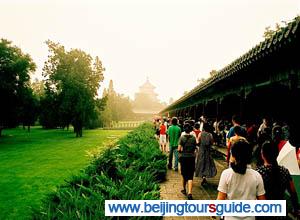
Temple of Heaven was listed in the World Heritage List in 1998. It is located in the south part of Beijing and is the place where emperors of Ming and Qing dynasties pray to the God of Heaven and Earth for a good harvest. The architecture is extremely precise, peculiar and fabulously beautiful and is regarded as the bright pearl of Chinese ancient buildings and also one in the world's architectural history.
The ancient China had a great worship to heaven and earth and the emperor of China was deemed as the Son of Heaven, so people should take an unquestioning obedience to the emperor’s reign. Therefore, the temple was built strictly to reflect the relationship of heaven and earth, which in the other hand emphasized the absolute and inviolable power of the emperor who represented the heaven. There are two tiers of walls where the north walls are in a circle shape and the south walls are in square shape by meeting at right angles with the west and east walls. This design is according the traditional Chinese geography theory, that is, the south is a square representing the earth and the north is a circle representing the heaven. Wall constructed according to this design was called Wall of Heaven and Earth. Another example is the emphasis of Son of Heaven, the emperor. In old China, the number 9 implies the emperor and is well expressed through the design of the Circular Mound Altar: a single round marble plate is in the center which is surrounded by 9 circles of different numbers of plates and the numbers are respectively 9,18,…9×9.
The temple covers an area of 2.73 million m² and consists of 3 main groups of architectures as follows:
The Hall of Prayer for Good Harvests
It is the main building of the temple used by the emperors of Ming and Qing dynasties to pray to heaven for a good harvest. The hall is a round architecture with triple conical roofs in an incorporated manner. The roof was all laid with dark blue glazed tiles as a symbol of the blue heaven. The building is 38 m high and 32.72 m in diameter. The inside hall is supported by 28 nanmu wood pillars whose layout is in the particular implications. The four pillars in the center are a symbol of four seasons , its inner circle of 12 pillars represent 12 months , the outside circle of 12 pillars are regarded as 12 Chinese hours ( 1 Chinese hour= 2hours),the two circles of 24 pillars are the twenty-four solar terms in China and all the 28 pillars are the 28 lunar mansions.
 |
| Temple of Heaven in the morning sun |
The Imperial Vault of Heaven
It is located in the south of Hall of Prayer for Good Harvest and is the place to lay aside memorial tablets of Supreme Ruler of Heaven and the emperor's last 8 generations of ancestors. It resembles Hall of Prayer for Good Harvest but only has one eave pyramidal roof. It is also called Echo Hall because sounds can be transmitted over great distances. It is a popular amusement by the tourists to speak and hear each other between long distances here.
The Circular Mound Altar
Situated in the south of the Imperial Vault of Heaven, it is the place where the emperor presided sacrifice to heaven on the day of midwinter for good weather in the coming year. It is constructed by 3 levels of marble circular platforms. In the center is a round stone plate named Heaven Stone. Stand on the Stone to make a shout or beat it to some noise and the echo will arise but much louder than the original seemingly a hundred responses to your call.
Entrance fee:
April 1-October 31: 35RMB
November 1- March 31: 30RMB


